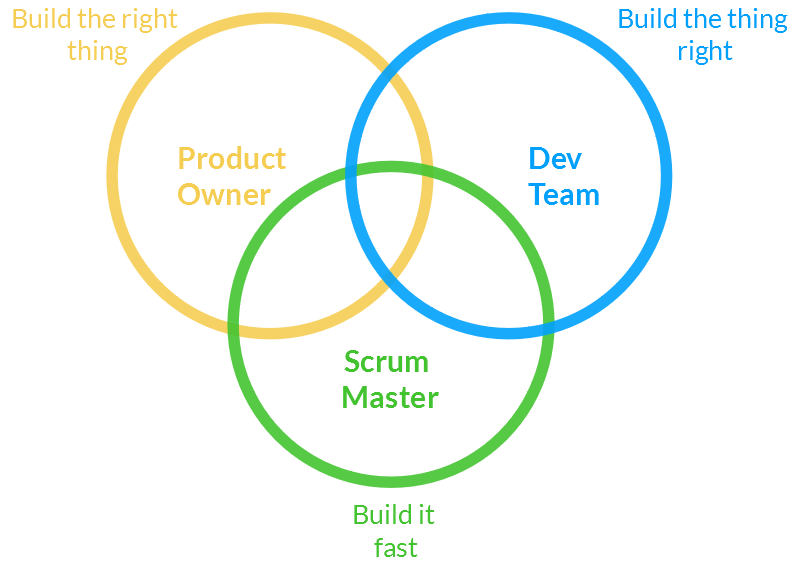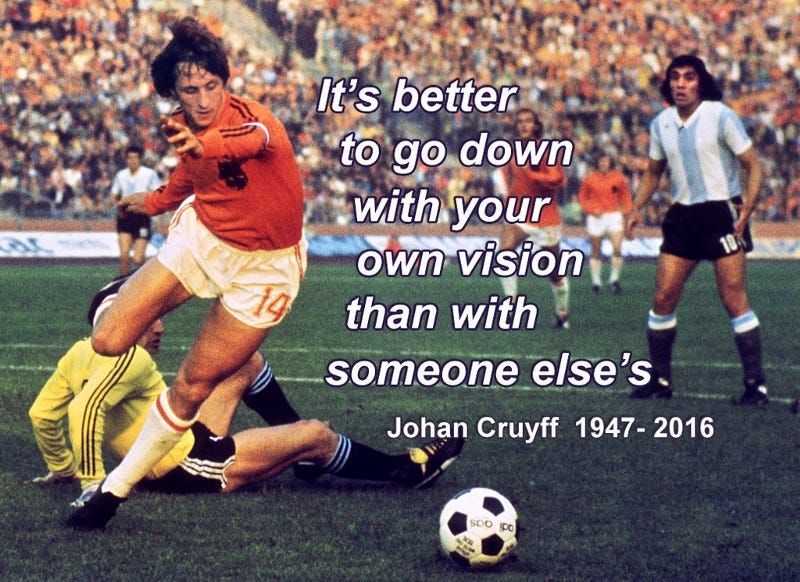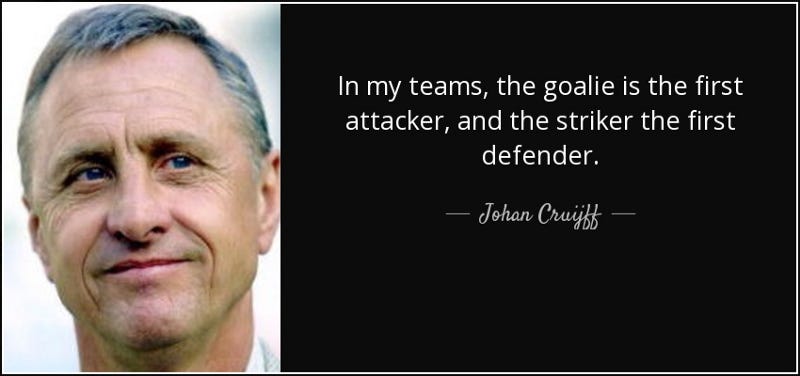Stop Talking So Much About the Different Scrum Roles
What Matters Most Is the Scrum Team And Their Common Goal
Anybody who started reading about Scrum probably stumbled on this diagram in some form or the other:
At first glance, the diagram appears to offer a highly condensed and informative view of the responsibilities of the different Scrum roles. Upon deeper inspection, this Venn diagram actually does more harm than good.
To show why it’s harmful, let’s make the same diagram for a football team, or a soccer team for you Americans. A diagram for a football team would look something like this:
The defense should prevent goals from being scored. The main job of the offense is to score goals. The midfield tries to keep the ball in possession and direct play towards the goal of the opponent. In a football team, every position has a clear separation of responsibilities.
I am aware my diagram isn’t perfect, e.g. for simplicity sake I’ve omitted the goalkeeper. But please bear with me for now, as it doesn’t really matter for the point I am trying to make.
Before 1974, this Venn diagram symbolizes the way football was played. Each squad member had their own, clear role to play in the football team. So what happened in 1974 that changed this?
At the 1974 World Cup, a tiny country stunned everyone and won hearts all over the world. The Dutch football team reached the finals by playing football in a way nobody had ever played before. The Dutch national side, captained by Johan Cruyff, was unable to win the final. But we will remember them for changing football forever.
Famous for their precision passing, the Dutch team was coined ‘A Clockwork Orange’. The way they played was called: Totaalvoetbal or ‘Total Football’. Wim Rijsbergen, a member of the 1974 World Cup squad, expressed their way of playing perfectly:
“We played with a lot of pressure on the other team, with a lot of risk in the back. The defenders went forward, the forwards came back. We played football. We even used the goalkeeper … as a libero, playing outside the area.” — Wim Rijsbergen
Total Footbal was exemplified by quick and fluid changes in position. Every player read the game, watched what other members of the team and the opposition were doing, and adapted their position and role accordingly. Attackers could become defenders and defenders could become attackers.
In Total Football, the roles of different team members still mattered, but team members were given the freedom to adapt their role depending on what the situation required. Total Football broke the silos that traditionally existed between different team positions.
Figuring out the best way to score more goals than your opponent was more important than respecting your position and place in the team.
The Whole Scrum Team Shares the Same Goal
Just like the football team, the Scrum Team shares a common goal. It is the goal of a Scrum Team to deliver products of the highest possible value. The Scrum Guide explains this clearly:
“Delivering Products of the Highest Possible Value.”
The whole team should work together to deliver products of the highest possible value. Each role in Scrum serves a specific purpose, but what matters most is delivering a valuable product.
Let’s circle back to the original picture that inspired me to write this article:
The separation of concerns this Venn diagram tries to depict is absolutely false. Everybody should care about all three, but they should care most about building the right thing. Let me elaborate by looking at this Venn diagram through the lens of the Scrum framework.
In general, Scrum cares most about building the right thing. If we deliver something that isn’t of value, who cares that we deliver it fast or with a high degree of technical excellence? It would have been better to never have delivered it at all.
Once we know we are building the right thing, then Scrum cares about building it fast and building it in the right way, because:
Building it faster means a quicker time-to-market. This means we will earn money sooner and discover if it really delivers the expected value earlier.
Building it the wrong way means we need to do rework or throw it away. Rework is way more expensive after go-live. The cost of maintenance of wrongly built things is higher, so the ROI of what we release will become lower. If we have built a lot of things wrong it will hamper our ability to respond to changes. We will not be able to respond quickly to changes in the market or deliver new features in a timely manner. More money is spent on hiring: developers are more likely to leave after being forced to work for a prolonged period of time on a platform with high technical debt. It may also become more difficult to get new developers to join.
All three elements of the Venn diagram impact delivering products of the highest possible value. Therefore, the whole Scrum Team should care about all three. If one element impacts delivered value more than the other, they should all care about this the most.
What element is most important can depend on your situation. But it all starts with a product that is valuable. And what matters is how each element impacts value of your product.
Working on a valuable legacy platform would shift the focus to building it right for the whole team. Working on a start-up with a valuable product where money is running out, time-to-market of new features to help close deals may be most important.
Scrum Teams Should Break Their Silos and Work Toward the Same Goal: Delivering a Valuable Product
Just like with football, every role in the Scrum Team plays a specific part. The most important thing in Scrum is to deliver a valuable product.
Cruyff himself later summarised Total Football as follows:
In a high-performing Scrum Team, everybody helps and challenges each other to achieve the best result: delivering a product of the highest possible value. The different roles matter, but they should form a fluid whole that helps each other to achieve the same goal.
Just because you’re not a Product Owner, does not mean you can’t talk about value and what we can do better to serve our customers and the business. Just because you‘re not a Development Team member, does not mean you can’t challenge the proposed technical solution. Just because you’re not a Scrum Master, doesn’t mean you can’t challenge how we do Scrum.
The Scrum Guide writes the following:
“Scrum recognizes no sub-teams in the Development Team, regardless of domains that need to be addressed like testing, architecture, operations, or business analysis” — Scrum Guide
I believe Scrum Teams should act in a similar way to the Development Team:
“Scrum recognizes no sub-teams in the Scrum Team. Regardless of role, every member of the Scrum Team should work towards the same goal: delivering products of the highest possible value.”
If we all work towards the same goal and coordinate our efforts, who really cares who does what?









This is why it is a set of accountabilities rather than a role. This way we can dip in and out of the accountabilities. Anybody that is causing the removal of impediments is exercising one of the scrum master accountabilities. Anybody that adapts the sprint backlog to align with the sprint goal has been exercising the Developer accountability. All members of a Scrum Team are equality accountable for creating a potentially shippable increment of value.
Great reading! What often gets lost in conversations about Scrum roles is that high-performing teams don’t obsess over boundaries, they operate through trust, flow, and mutual challenge.
One thing I’d add: role "fluidity" doesn’t mean role ambiguity.
In great teams, responsibilities are clear, but no one hides behind them.